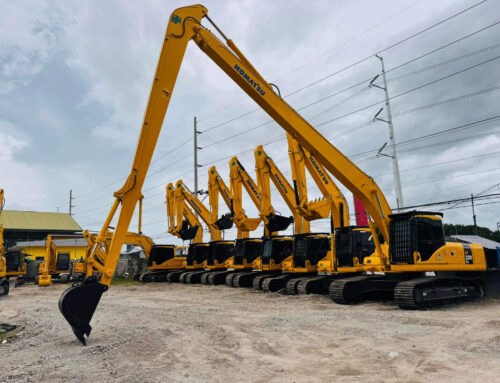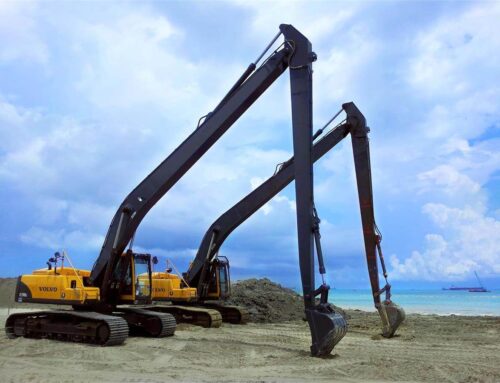In the world of construction and mining, the excavator is a symbol of raw power and precision. These versatile machines can dig deep into the earth, remove tons of material, and shape landscapes with remarkable accuracy. One critical component that has played a pivotal role in enhancing the performance of excavators, especially in the realm of mining and quarrying, is the rock boom. This article takes you on a journey through time, exploring the development of excavator rock booms and how they have revolutionized the way we extract valuable resources from the Earth.
The Birth of the Excavator
To truly appreciate the significance of the excavator rock booms, we must first understand the origins of the excavator itself. The concept of a mechanical digging machine dates back centuries, with various designs and iterations emerging over time. However, the modern hydraulic excavator, as we know it today, didn’t come into existence until the mid-20th century.
It was in the 1950s that hydraulic systems were integrated into excavators, providing them with the unparalleled strength and precision needed for heavy-duty excavation tasks. This advancement marked the beginning of a new era in construction and mining equipment, laying the foundation for the development of specialized attachments like the rock boom.
The Early Excavator Rock Booms
In the early days of hydraulic excavators, rock-breaking attachments were relatively rudimentary. The primary tool used for rock excavation was the hydraulic hammer, which relied on a pneumatic or hydraulic mechanism to deliver powerful blows to break apart rocks. While effective, these early attachments had limitations when it came to precision and control.
The Birth of the Excavator Rock Booms
As the demand for more efficient rock excavation methods grew, engineers and manufacturers began developing the rock boom. The rock boom is a specialized attachment that can be fitted to an excavator’s arm. It is designed to provide controlled and powerful force directly to the rock’s surface, allowing for precise excavation and reduced collateral damage to surrounding areas.
Hydraulic systems played a critical role in the evolution of the rock boom. These systems allowed for finer control over the boom’s movements, resulting in improved accuracy and safety for operators. The incorporation of advanced materials and engineering techniques also made rock booms more durable and efficient.
The Evolution of Design
Over the years, the design of rock booms has undergone significant changes and improvements. One of the most notable developments is the introduction of articulated rock booms. These booms consist of multiple sections connected by hydraulic joints, which provide greater flexibility and maneuverability.
Articulated rock booms allow operators to reach challenging angles and positions, making them ideal for excavating in confined spaces, such as tunnels or tight quarry areas. This design innovation has been a game-changer for the mining and construction industries, enabling access to previously inaccessible resources.
Precision at its Finest
The evolution of excavator rock booms has been driven by a relentless pursuit of precision. Modern rock booms are equipped with advanced technology, such as sensors and computerized control systems, which enable operators to fine-tune their movements with incredible accuracy.
These sensors can detect changes in rock density and hardness, allowing the excavator to adjust its digging force accordingly. This not only improves efficiency but also prolongs the life of the equipment by reducing wear and tear. The ability to adapt to varying rock conditions has made excavator rock booms indispensable in mining operations around the world.
Safety and Environmental Benefits
Beyond their precision and power, excavator rock booms have also brought about significant safety and environmental benefits. The controlled and precise nature of rock boom operation minimizes the risk of accidents, reducing the potential for injuries to operators and damage to nearby structures.
Furthermore, the precise excavation offered by rock booms means less material is wasted, leading to more sustainable mining and construction practices. This efficiency not only saves time and money but also reduces the environmental impact of resource extraction.
Future Innovations
As technology continues to advance, the future of excavator rock booms looks even more promising. Engineers are exploring the integration of automation and artificial intelligence to further enhance their capabilities. Autonomous excavators equipped with advanced rock boom technology could operate in hazardous environments without human intervention, improving safety and productivity.
Moreover, the development of alternative power sources, such as electric and hydrogen-powered excavators, may lead to cleaner and more sustainable rock excavation practices in the years to come. These innovations hold the potential to revolutionize the construction and mining industries, ushering in a new era of efficiency and environmental responsibility.
Conclusion
The excavator rock boom is a testament to human ingenuity and the relentless pursuit of innovation in the field of construction and mining equipment. From its humble beginnings as a basic rock-breaking attachment to the advanced, precision-driven technology of today, the rock boom has played a pivotal role in transforming how we extract valuable resources from the Earth.
With ongoing advancements in materials, design, and technology, excavator rock booms continue to push the boundaries of what is possible in the world of excavation. As we look to the future, these remarkable machines promise to revolutionize the construction and mining industries, making them safer, more efficient, and more sustainable than ever before.








Leave A Comment